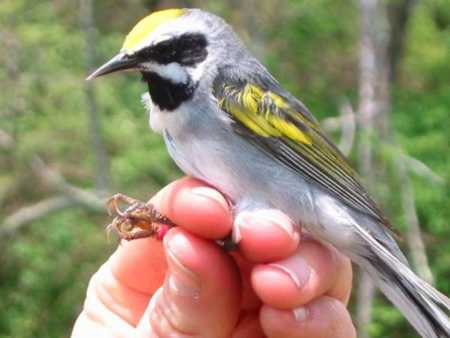Plight of Golden-winged Warbler, Not So Golden
Reprinted from the Spring 2007
Tamarac Interpretive Association- Tamarac Highlights
By Wayne Brininger
Refuge Biologist
The Golden-winged warbler is among the most vulnerable and steeply declining of North American passerines, yet its patchy distribution is not well-monitored in many parts of its range. Breeding Bird Survey routes have documented the population decline since 1966, with annual rates of decline of 2.5% throughout its breeding range. The most abrupt declines have occurred in the northeastern U.S. (7.6% decrease per year); while the population has remained stable in the northern and northwestern portions of its range where farmland abandonment and timber harvest of aspen is common. Nationally, the decline may be due, in part, to a loss of habitat resulting from forest succession; change in forest management practices, such as reduced clear-cutting; development; and coal mining . In addition, this decline correlates with the range expansion of the Blue-winged warbler. The northward expansion and zone of overlap into the range of the Golden-winged warbler has led, not only to increased competition, but also to widespread interbreeding between the Golden-winged and Blue-winged warblers. Because of this wide-spread hybridization, populations of pure Golden-winged warblers may soon disappear.

Fish and Wildlife Service Photo
Golden-winged warblers can be seen at Tamarac Refuge along woodland edges and in young aspen stands. Scientists are looking at habitat loss, hybridization with the Blue-winged Warbler, global climate change and the ability to survive in their wintering grounds of Central and South America as possible reasons for the decline.
|
The Golden-winged warbler is currently listed as a Resource Conservation Priority species by the U.S. Fish and Wildlife Service and is considered a neo-tropical migratory species of high continental conservation concern by Partners in Flight, which is a collaboration of federal, state and local government agencies; professional organizations; conservation groups; and interested others. An estimated 82% of the global population of Golden-winged warblers breed within Minnesota, Wisconsin and Ontario. A vital 42% the global population breed solely within Minnesota; thus, Minnesota has an obligation to manage the Golden-winged warbler as a stewardship species.
Undoubtedly, Tamarac National Wildlife Refuge has significantly contributed to the regional Golden-winged warbler population in recent years through an active timber harvest program directed toward young aspen management or early successional habitat; however, an accurate population assessment has never been conducted on the refuge to document this contribution. Recent habitat assessments have indicated that the refuge is trending away from early successional habitat, and many of the highly preferred aspen-regenerating clearcuts are succeeding to older age classes. Although the Golden-winged warbler has been studied extensively in eastern North America, basic information on habitat association and reproductive success has never been conducted in the core of its range (Minnesota and Wisconsin). Inadequate information on its life history and requirements is one of the key obstacles to conserving the species.
In 2006, a research project was initiated on Tamarac Refuge to assess the total population of Golden-winged warblers and to determine the densities at which they exist in the available habitat types on the refuge. This information can be used in predictive habitat models and estimates of regional population size. Since there has never been a site-specific census within Minnesota, data from this Tamarac survey will contribute significantly to improving regional population estimates. Tamarac NWR is working with Concordia College to gather data. Watch for Concordia students working in the field this summer as they listen for the “zee bee bee bee” of the Golden-winged warbler.
|
